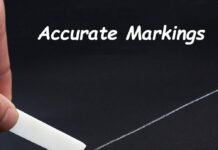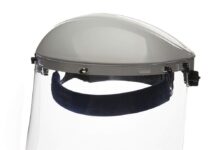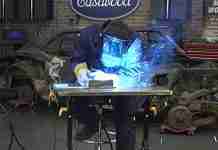When finding the perfect custom welding table, certain must-have features can make all the difference in your welding projects.
From a sturdy and durable frame to an adjustable work surface, these essential elements ensure that your welding table provides a stable platform for your work and allows you to work efficiently and effectively. Join us as we explore the key features every welding enthusiast should consider when investing in a custom table.
Sturdy Construction
When it comes to a custom welding table, one of the key features we look for is sturdy construction. We want a table that can withstand the rigors of daily use and provide a stable and reliable work surface. That’s why heavy-duty materials are essential. Whether it’s steel, aluminum, or another durable material, we want a table that can handle the demands of welding projects without bending or warping.
In addition to the materials used, a strong frame is crucial for the overall stability and durability of the welding table. The frame should be designed to distribute weight evenly and provide a secure base for our welding activities. This means we can work confidently, knowing the table will stay in place and support even the heaviest workpieces.
Another critical aspect of sturdy construction is reinforced corners. Welding tables often undergo heavy use and can be subjected to significant impact. Reinforced corners help to prevent damage to the table and ensure that it remains solid and secure over time. By reinforcing the corners, we can increase the lifespan of the welding table, saving us money and hassle in the long run.
Durable Surface
Welding involves intense heat, sparks, and potentially abrasive materials. A durable surface is an absolute must-have for a custom welding table. The surface should be able to withstand high temperatures without warping or melting. A heat-resistant coating can provide this protection, ensuring that our table remains in top condition even after prolonged exposure to welding heat.
In addition to being heat-resistant, the surface should also be non-slip. Welding involves precision and accuracy, and a non-slip surface ensures that our workpieces stay in place during the welding process. This prevents any accidents or mishaps due to the workpiece shifting unexpectedly.
Furthermore, we want a surface that is resistant to scratches and dents. Welding projects often involve heavy and sharp objects that can potentially damage the table’s surface. By having a coating or material that is scratch and dent-resistant, we can maintain a smooth and even work surface, ensuring that our welding projects turn out flawlessly.
Adjustable Height
Comfort is essential when it comes to working on a welding table. That’s why adjustable height is a must-have feature. With a table with various height options, we can position ourselves ergonomically, reducing strain on our backs, necks, and arms. This ergonomic design promotes better working conditions and enhances productivity by allowing us to work comfortably for extended periods.
Flexible working positions are crucial when it comes to welding projects. Different tasks may require different angles and positions to ensure accuracy and precision. By having adjustable height options, we can easily switch between sitting and standing positions and find the perfect height for each specific task. This flexibility ensures that our welding table is versatile and adaptable to our needs.
Moreover, easy height adjustment is essential for increasing efficiency and limiting downtime. We want a table that allows us to change the height quickly and effortlessly without needing additional tools or complicated mechanisms. This saves us time and energy, enabling us to focus on what matters most – our welding projects.
Clamping and Fixturing Options
Clamping and fixturing options are crucial features in a custom welding table to ensure the stability and precision of our welding projects. Integrating clamps is highly convenient whether working with small or large workpieces. These clamps provide a secure hold on the workpiece, ensuring it stays in place during welding. This allows us to achieve accurate, high-quality welds without movement or shifting.
Toggle clamps are another valuable addition to a welding table. These clamps are fast and easy to use, providing quick and reliable clamping options. They can be adjusted to various positions and offer a tight grip, making them ideal for securing different sizes and shapes of workpieces.
Quick-release mechanisms are an additional feature that simplifies the clamping and fixturing process. When we need to move or reposition our workpiece, a quick-release mechanism allows us to release the clamps quickly and seamlessly. This saves us time and effort, allowing for smoother workflow and increased productivity.
Versatile Work Surface
A versatile work surface is a must-have for custom welding tables. We want a table that can adapt to welding projects and accommodate various workpieces. A flat tabletop is essential for providing a stable, even surface to work. This ensures that our welds are neat and precise, without any unwanted distortions or deformations.
Various hole patterns on the table can be beneficial to enhance versatility. These hole patterns allow us to secure clamps, fixtures, and other accessories at different points on the table. This ensures we can position our workpieces most suitably and conveniently, allowing for efficient and accurate welding.
Removable inserts are another valuable feature of a versatile welding table. By having inserts that can be easily removed or interchanged, we can customize our work surface to suit our specific needs. Whether we need a smooth surface for delicate work or a grid pattern for easier clamping, removable inserts allow us to modify the table to accommodate different welding projects.
Integrated Storage Solutions
Efficient storage is essential for any workspace; a custom welding table should be no exception. Integrated storage solutions offer convenience and organization, ensuring our tools and accessories are easily accessible and well-kept. Tool trays provide a dedicated space for frequently used tools, keeping them within reach and saving valuable time searching for what we need.
Drawer compartments add even more versatility to the storage options of a welding table. These compartments can store smaller tools, spare parts, and other essentials that we want to keep organized and protected. With these compartments built into the table, everything we need is conveniently located at our fingertips.
Shelving or racks on the welding table offer additional storage space for more oversized items or materials we may need throughout our welding projects. These storage solutions make it easy to keep our workspace tidy and ensure that everything is readily available when we need it. No more wasting time searching for tools or materials – we can work efficiently and effectively with integrated storage solutions.
Mobility
Sometimes, welding projects require us to move our workspace around. That’s why mobility is an essential feature in a custom welding table. Lockable casters allow us to easily transport the table from one location to another, whether within our workshop or to a different worksite. The ability to lock the casters in place ensures that the table remains stable and secure during welding, preventing unwanted movement or shifting.
A handle or towing option is another valuable addition for mobility. Depending on the size and weight of the welding table, having a handle or a towing mechanism makes it easy to maneuver and transport it as needed. This feature is handy when working in more extensive workshops or moving the table through narrow spaces.
Additionally, a compact design for transportation is highly desirable. We want a welding table that can be easily disassembled or folded, allowing us to transport it compactly. This ensures that the table can fit in our vehicles without taking up excessive space, making it convenient for those who often need to transport their welding equipment.
Welding Accessories Compatibility
A custom welding table should be compatible with various accessories to enhance its functionality. Welding clamps are commonly used to hold workpieces in place during welding securely. Ensuring that the table is compatible with different types and sizes of clamps allows us to expand our capabilities and accommodate a wide range of welding projects.
Accessories holders are another valuable feature that enhances the organization and accessibility of our welding equipment. These holders can be attached to the welding table, keeping our accessories within easy reach and preventing them from getting misplaced or lost. We can work efficiently without unnecessary interruptions with dedicated holders for welding helmets, gloves, torches, and other tools.
Mounting points for additional tools offer further customization options for a custom welding table. With these mounting points, we can attach specialized tools or fixtures required for specific welding tasks. This adaptability allows us to tailor the table to our needs and ensure we have everything we require for efficient and precise welding.
Heat Resistance and Welding Safety
Safety should always be a top priority when welding; a custom welding table should reflect this. Heat-resistant materials are essential to protect the table from damage caused by the intense heat generated during welding. We can work confidently with heat-resistant materials, knowing that our table will not warp, melt, or become structurally compromised.
Fire-retardant coatings offer additional protection against any sparks, stray embers, or accidental fires that can occur during the welding process. These coatings help prevent the spread of fire and protect the table and the surrounding environment from potential damage.
Furthermore, safety precautions like spark arrestors should be considered when designing a custom welding table. Spark arrestors are specifically designed to prevent sparks from escaping and causing fires. By incorporating spark arrestors into the table’s design, we can minimize the risk of accidents and ensure a safe working environment.
Customizability
Every welder has unique preferences and requirements, and a custom welding table should be able to accommodate these individual needs. That’s where customizability comes into play. A modular design allows us to add or remove different features and accessories, tailoring the table to our specific requirements. Whether it’s additional storage, a different table size, or specialized tool mounting options, a modular design ensures the welding table is truly personalized.
Add-on features are another way to customize a welding table. These features include adjusting arms, lighting options, or even integrated power outlets. By incorporating these add-on features, we can further enhance the functionality of the welding table and create a workspace that caters specifically to our needs.
Moreover, personalized dimensions should be an option when considering a custom welding table. Different welding projects may require different sizes and shapes of work surfaces. By offering personalized dimensions, manufacturers can ensure that the welding table meets the specific spatial requirements of each welder, resulting in a workspace that is comfortable and efficient.
In conclusion, a custom welding table should possess several must-have features to ensure a productive and safe welding experience. Sturdy construction, a durable surface, adjustable height, and clamping options provide the foundation for a reliable and versatile work surface.
Integrated storage solutions, mobility, compatibility with welding accessories, heat resistance, and customizable options further enhance the functionality and convenience of the welding table. By investing in a custom welding table that encompasses these essential features, we can create a workspace that meets our unique needs and allows us to excel in our welding projects.




































